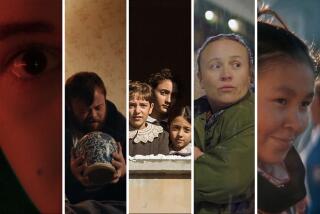Breaking Out of Bollywood
- Share via
Director Ashutosh Gowariker has spent his entire career in Bollywood, India’s thriving movie industry that produces hundreds of films a year, mainly lavish melodramatic spectacles filled with action, costumes, song and dance. But when he worked on his new movie, he had something different in mind: a film that would be non-formulaic yet still had significant commercial appeal.
The result, “Lagaan: Once Upon a Time in India” has succeeded on both fronts: It’s been acclaimed by critics, fared well at the box office, and, with its themes of oppression, unity and triumph, was considered unlike anything seen before by Indian audiences.
Now it’s up for an Oscar.
“Lagaan” is one of only three films from India ever to be nominated for best foreign-language film--and the only true Bollywood film chosen. The other two were more art-house fare: “Mother India” (1957) and “Salaam Bombay!” (1988). “Lagaan’s” lead actor, Aamir Khan, noted that getting an Oscar nomination was “an uphill task. Most members [of the nominating committee] had never even heard of it.”
But now that the film has made it this far and is in the running alongside France’s “Amelie,” Norway’s “Elling,” Bosnia’s “No Man’s Land” and Argentina’s “Son of the Bride,” Gowariker--who directed and wrote “Lagaan”--feels vindicated.
After all, he began with the most nebulous of ideas: wanting to tell a story about “people getting together to achieve a common goal, to fight oppression. I wanted a story of reunification.” He wanted it to be “bloodless,” unlike the often violent scenes prevalent in Bollywood films. Instead of one hero--again, the case in most films from India--there had to be a group of heroes and victors. It had to be accurate and believable, so much so that the actors speak in the central Indian dialect native to the area in which the movie was set.
It was originally to have been set in contemporary times, before Gowariker realized that such a story “would have been filled with jaded characters, politicians and policemen.” So he then tried shifting the time line back to 1947, when the British colonial rulers were, he says, “the biggest oppressors.” But staging the film in that era would have brought with it other challenges.
“It was difficult to get away from the freedom movement, but it would have been irresponsible of me to set a movie in 1947 and not feature the freedom movement,” he said recently over a cup of masala chai at an Indian restaurant in Beverly Hills. “Instead, I wanted those emotions [of oppression] to be simmering.”
So he ended up in 1893, when Indians “believed that colonial rule would go on for another hundred years, Gowariker said. “The British collected taxes [lagaan means ‘tax’ in Hindi], which were shared with the maharajahs of each province.”
And, while overseeing the Indians, they spent their idle hours playing polo, croquet and cricket.
Which is where Gowariker’s story comes in. The people of a small rural village in the most arid parts of central India can barely afford to pay their taxes--in the form of wheat and grains--when the British impose even greater levies.
The unsympathetic head of the regiment, Capt. Russell (played by Paul Blackthorne) cavalierly dares the farmers to beat the English team in a game of cricket. If they win, all taxes for the next three years will be wiped out. If they lose, they pay triple. Bhuvan, played by Khan, is the young de facto leader of the villagers and is alone in his decision to accept the challenge.
The plot is an unusual one for Bollywood, which prefers cop-versus-bad guy dramas and straight Hollywood rip-offs. But other elements are pure Bollywood--the length (a whopping three hours and 42 minutes) and the numerous song-and-dance sequences peppered throughout the movie. Gowariker believes that American audiences will embrace the film despite its length and genre-mixing style. (The film opens May 10 in Los Angeles and New York.)
“I don’t see any reason why the U.S. should not accept mainstream Indian cinema for what it is, usually three hours long or more,” Gowariker says. “And it’s always going to be a musical. That’s just the way it is, and we’re proud of it. Indian movies must be realized in all their splendor.”
Observers say the film could help pave the way for future Bollywood productions reaching the U.S. market.
“It will be a wonderful introduction of Bollywood to mainstream audiences, although Bollywood films are typically more flashy,” said Michigan-based entertainment consultant Vipul Gupta, who described the film as “an epic story in the vein of ‘Gandhi.’ It is a universal story.”
Certainly “Lagaan” is a mixed bag of genres--romance, action, musical, a comedy of sorts--all set in a period piece. But Gowariker, who has also acted in numerous Indian productions since 1984, said the time was right for such non-formulaic fare.
“I was tired of the films that were being thrown at me,” he said. “It was so exciting for me to write this and to make it, and I had a sense that audiences would appreciate it. I would have been heartbroken if they hadn’t.” The film cost about $6 million, more than double the budget for most Bollywood films. It has grossed about $14 million so far in India and about $20 million worldwide.
“I felt it could be a crossover film, one that showed simplistic morals and the triumph of the human spirit. These are universal things. Wherever there has been oppression, this could appeal,” Gowariker said.
The sentiment of unity was driven home by other factors. The film shows Christians, Muslims, Hindus and Sikhs, all of whom have had fractious periods in India’s history, coming together to try to beat the British at their own game. The motley team assembled by Bhuvan even includes a harijan, one of the country’s “untouchables.”
When the movie opened in India last summer, critics raved. Pritish Nandy, writing in India’s Mid-Day newspaper, called “Lagaan” an “amazing movie” with “flawless teamwork ... a work that will go down in the annals of cinematic history.” Amitabh Bachchan, a screen veteran on the subcontinent, wrote a piece for the Times of India calling “Lagaan” “a totally perfect film.”
The Oscar nomination has meant global viewership. Since the nominations were announced, the film has been picked up by distributors in Venezuela, Zambia and Taiwan, countries that don’t usually screen Hindi-language films.
“It’s a movie that doesn’t just represent India, but also Indian culture,” Gowariker said. “That is the most fulfilling part.”
*
Kavita Daswani is an occasional contributor to Calendar.
More to Read
Only good movies
Get the Indie Focus newsletter, Mark Olsen's weekly guide to the world of cinema.
You may occasionally receive promotional content from the Los Angeles Times.








